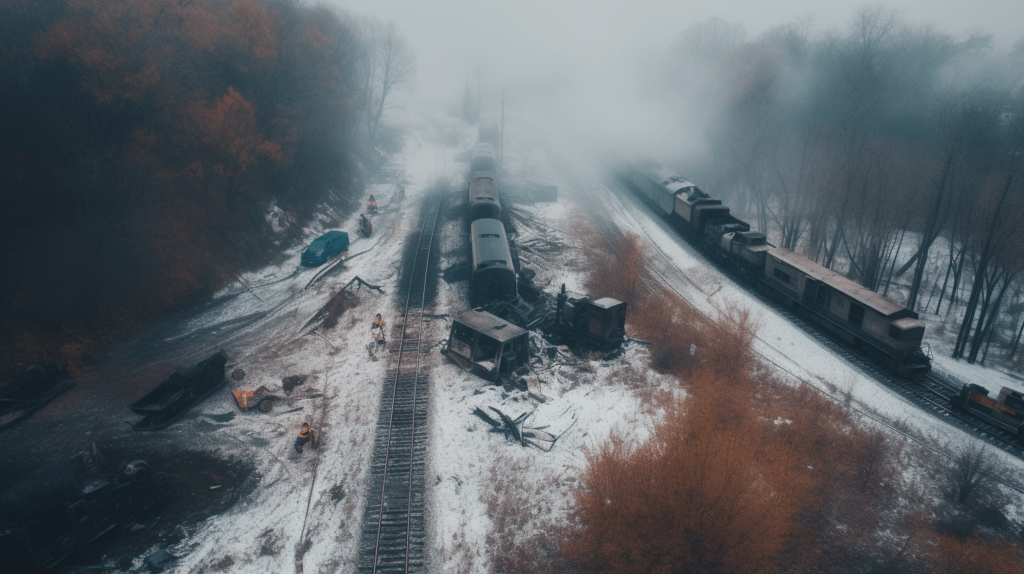The Ohio Train Derailment: What Impact Will This Chemical Spill Have on the Environment?

On February 3, 2023, a train transporting toxic chemicals derailed in eastern Ohio, causing these chemicals to spill and be released into the surrounding environment. So, how exactly did the Ohio train derailment happen? According to sources, a rail car axle failed due to a mechanical defect, causing the train to derail from the tracks, which led to the chemical spill that has many wondering what the long term effects of the catastrophe will be.
What Exactly Was In the Train Cars?
While it is known that the train was transporting toxic chemicals, you may not know exactly which chemicals were on the train. It was discovered that at least five of the cars that were damaged in the Ohio train derailment were carrying vinyl chloride, which is a known carcinogen. Vinyl chloride is a colorless gas that is used to make plastic products, and is known to cause dizziness, headaches, and drowsiness when inhaled.
How Did We Respond?
Following the derailment of the train, an evacuation order was issued for the surrounding area. While this order has since been lifted, many residents are skeptical and still face uncertainty about the long term effects of the derailment.
After the chemical leak, safety crews began venting and burning the chemical cargo in the train cars in order to prevent an explosion from happening. It is likely you have seen photos of a massive black smoke plume where the derailment happened–this was the result of the controlled burning of the chemicals.
What Effects Will This Derailment Have on Humans and the Environment?
Unfortunately, there is no way to know for certain the long term effects that the Ohio train derailment and chemical spill will have on the surrounding areas, and how it will affect the people and environment in this area or beyond. As previously stated, the evacuation order has been lifted for those residing in the surrounding area, but many are skeptical.
The Environmental Protection Agency has been monitoring the air inside the buildings of the surrounding areas, and stated that they had not detected any harmful gasses inside of homes thus far. However, this does not mean that the air is one hundred percent safe. When there is a chemical plume, particles can settle on the ground and seep into the walls or drinking water sources as time goes on. Authorities are recommending that as residents return to their homes, they open windows and wipe down all surfaces as a precaution. While the air seems safe enough now, there is unfortunately no way to know the long term effects of what this chemical spill will have in the future.
According to Mary Mertz, director of the Ohio Department of Natural Resources, roughly 3,500 fish including 12 common species died in the creeks near the derailment. However, since February 14, Mertz stated that there was not an apparent increase in the number of fish or other aquatic species killed as a result of the derailment. Additionally, there is currently no evidence of non-aquatic species suffering due to the accident.
While no traces of vinyl chloride have been detected in the Ohio River thus far, there has been a chemical plume of butyl acrylate that made its way to the river and is currently being monitored as it continues downstream. Ohio Governor Mike DeWine’s office has stated that the level of butyl acrylate in the water is below three parts per billion, which is “well below the 560 parts per billion the CDC considers hazardous.” Even with the butyl acrylate levels below what the CDC considers hazardous, it is still worth monitoring, as exposure can cause headache, dizziness, nausea, and vomiting.
What Does This All Mean?
Without knowing the long term effects that this chemical spill will have on us makes it difficult to know exactly what this means for the area affected, especially when we are not entirely sure how far of a reach the impact of the derailment will have. While initial harm has proven to be to wildlife, there are still questions to be asked as to when and how this spill might impact the people living in the area.
This unexpected exposure to pollutants definitely has us worried for both the potential impacts on the environment and on the people occupying the area where the derailment occurred. While we are constantly looking for ways to make our planet a better place to live, unexpected events like this one are unfortunately bound to happen. While we cannot always predict or prevent these catastrophes from happening, what we can do is have a plan of action in place for when environmental accidents do occur. By working together to reduce the harm done when these things happen, we can continue to try to make the world a better place to live.
In order to protect our world, we hope that this chemical spill will continue to be monitored for the long term so we can be more aware of any delayed effects that accidents like this may have on the environment and the people involved. This disaster will serve as a reminder that we all should be making an effort to do what is best to respect and improve the environment. No matter how small our efforts may seem, if we put forth the effort to serve the environment, we can truly make the world a better place.
Get the latest news from
Better Earth in your inbox.
